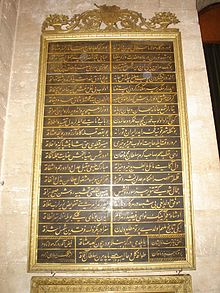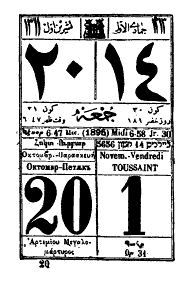ภาษาตุรกีออตโตมัน
| ภาษาตุรกีออตโตมัน | |
|---|---|
| لسان عثمانى lisân-ı Osmânî | |
 ตุรกีออตโตมันในรูปอักษรแนสแทอ์ลีก (لسان عثمانى) | |
| ภูมิภาค | จักรวรรดิออตโตมัน |
| ชาติพันธุ์ | ชาวเติร์กออตโตมัน |
| ยุค | ป. คริสต์ศตวรรษที่ 15; แทนที่ด้วยภาษาตุรกีสมัยใหม่ใน ค.ศ. 1928[1] |
| ตระกูลภาษา | เตอร์กิก
|
| รูปแบบก่อนหน้า | ภาษาตุรกีอานาโตเลียเก่า
|
| ระบบการเขียน | อาหรับแบบออตโตมัน |
| สถานภาพทางการ | |
| ภาษาทางการ | เบย์ลิกแห่งตูนิส รัฐครีต เอมิเรตญะบัลชัมมัร รัฐเคดีฟอียิปต์ จักรวรรดิออตโตมัน รัฐบาลชั่วคราวแห่งชาติประจำคอเคซัสตะวันตกเฉียงใต้ รัฐบาลชั่วคราวแห่งเธรสตะวันตก รัฐบาลสมัชชาใหญ่แห่งชาติ ประเทศตุรกี (จนถึง ค.ศ. 1928)[a] |
| รหัสภาษา | |
| ISO 639-2 | ota |
| ISO 639-3 | ota |
| นักภาษาศาสตร์ | ota |
ภาษาตุรกีออตโตมัน (ตุรกีออตโตมัน: لِسانِ عُثمانى, lisân-ı Osmânî, เสียงอ่านภาษาตุรกี: [li'saːnɯ os'maːniː]; ตุรกี: Osmanlı Türkçesi; อังกฤษ: Ottoman Turkish) เป็นรูปแบบหนึ่งของภาษาตุรกีที่เคยเป็นภาษาในการปกครองและภาษาเขียนในจักรวรรดิออตโตมัน เป็นภาษาที่มีคำยืมจากภาษาอาหรับและภาษาเปอร์เซียมาก เขียนด้วยอักษรอาหรับ ภาษานี้ไม่เป็นที่เข้าใจในหมู่ชาวตุรกีที่มีการศึกษาต่ำ[3] อย่างไรก็ตาม ภาษาตุรกีที่ใช้พูดในทุกวันนี้ได้รับอิทธิพลจากภาษาตุรกีออตโตมันเช่นกัน
ในช่วงจุดสูงสุดของอำนาจออตโตมันเมื่อ (ป. คริสต์ศตวรรษที่ 16) ศัพท์ต่างชาติในวรรณกรรมตุรกีในจักรวรรดิออตโตมันมีจำนวนมากกว่าศัพท์ตุรกีดั้งเดิม[4] โดยในบางข้อความมีศัพท์ภาษาอาหรับและเปอร์เซียมากถึงร้อยละ 88[5]
โครงสร้าง
[แก้]
เช่นเดียวกับภาษากลุ่มเตอร์กิกอื่น ๆ ที่ใช้พูดในหมู่ชาวมุสลิม คำยืมภาษาอาหรับไม่ได้เกิดจากการติดต่อกันโดยตรงระหว่างภาษาตุรกีออตโตมันกับภาษาอาหรับ แต่มีหลักฐานว่ามาจากการเปลี่ยนเสียงตามแบบภาษาเปอร์เซียสำหรับคำที่ยืมมาจากภาษาอาหรับ การที่ยังคงรักษาการลักษณะการออกเสียงของการยืมคำจากภาษาอาหรับแบบนี้ไว้ได้ แสดงว่ามีการแพร่หลายของผู้พูดภาษาเปอร์เซียที่มีคำจากภาษาอาหรับอยู่มากเข้ามาในบริเวณนี้ ก่อนการก่อตั้งจักรวรรดิออตโตมัน ชนกลุ่มนี้เคยอยู่ทางตะวันออกเฉียงเหนือของเปอร์เซียก่อนจะอพยพมาทางตะวันตกเข้ามายังบริเวณที่ชนเผ่าเตอร์กอาศัยอยู่ ภาษาตุรกีออตโตมันมีคำยืมภาษาอาหรับที่มีรูปแบบของภาษาเปอร์เซียในแบบเดียวกับภาษากลุ่มเตอร์กิกอื่นๆที่เคยมีการติดต่อค้าขายกับชาวอาหรับเช่น ภาษาตาตาร์และภาษาอุยกูร์ ภาษาตุรกีออตโตมันมี 3 ระดับคือ
- Fasih Türkçe: เป็นภาษาที่ใช้ในกวีนิพนธ์และการปกครอง
- Orta Türkçe: เป็นภาษาที่ใช้สำรับชนชั้นสูงและการค้าขาย
- Kaba Türkçe: เป็นภาษาสำหรับคนชั้นต่ำ
คนที่ใช้ภาษาทั้งสามระดับจะมีจุดประสงค์ต่างกัน ตัวอย่างเช่น อาลักษณ์จะใช้คำจากภาษาอาหรับ Arabic asel (عسل) เพื่อหมายถึงน้ำผึ้งเมื่อเขียนเอกสาร แต่จะใช้คำพื้นเมืองภาษาตุรกี bal เมื่อต้องการซื้อน้ำผึ้ง
| ภาษาไทย/อังกฤษ | ตุรกีออตโตมัน | ตุรกีสมัยใหม่ |
|---|---|---|
| obligatory | واجب vâcib | zorunlu |
| hardship | مشکل müşkül | güçlük, zorluk |
| เมือง | شهر şehir | kent/şehir |
| สงคราม | جنگ cenk | savaş |
ประวัติศาสตร์
[แก้]ภาษาตุรกีออตโตมันแบ่งเป็นสามยุคคือ
- Eski Osmanlı Türkçesi เป็นภาษาที่ใช้จนถึงพุทธศตวรรษที่ 21 มีลักษณะที่ใกล้เคียงกับภาษาตุรกีที่ใช้โดยเซลจุกและถือเป็นส่วนหนึ่งของภาษาตุรกีอนาโตเลียโบราณ
- Orta Osmanlı Türkçesi เป็นภาษายุคกลางหรือภาษาตุรกีออตโตมันคลาสสิก เป็นภาษาที่ใช้ในกวีนิพนธ์และการปกครองตั้งแต่พุทธศตวรรษที่ 21 จนถึงยุคของตันซิมัต เป็นรูปแบบของภาษาตุรกีออตโตมันในความรู้สึกของคนทั่วไป
- Yeni Osmanlı Türkçesi ภาษายุคใหม่ เป็นภาษาที่เปลี่ยนรูปไปในช่วง พ.ศ. 2393 จนถึงพุทธศตวรรษที่ 25 โดยได้รับอิทธิพลจากงานเขียนของโลกตะวันตก
การเปลี่ยนรูปของภาษา
[แก้]ใน พ.ศ. 2471 หลังจากการสิ้นสุดของจักรวรรดิออตโตมันหลังสงครามโลกครั้งที่ 1 และมีการจัดตั้งสาธารณรัฐตุรกี ได้มีการเปลี่ยนรูปของภาษาโดยมุสตาฟา เกมาล อตาเตอร์ก โดยการแทนที่คำยืมภาษาเปอร์เซียและภาษาอาหรับด้วยคำดั้งเดิมในภาษาตุรกีที่มีความหมายเหมือนกัน และใช้อักษรละตินแทนอักษรอาหรับ ถือเป็นการสร้างภาษาตุรกีรูปแบบใหม่ เพื่อสร้างเอกลักษณ์ของชาติในยุคหลังจักรวรรคิออตโตมัน
มรดก
[แก้]ภาษาตุรกีออตโตมันไม่ถือว่าเป็นบรรพบุรุษของภาษาตุรกีสมัยใหม่ ความแตกต่างที่สำคัญของภาษาตุรกีทั้งสองแบบนี้คือการสร้างคำประกอบตามแบบไวยากรณ์ภาษาอาหรับและภาษาเปอร์เซียในภาษาแบบออตโตมัน ตัวอย่างเช่น คำว่า takdîr-i ilâhî เป็นการสร้างคำแบบภาษาเปอร์เซีย ภาษาตุรกีสมัยใหม่จะเป็น ilâhî takdîr
ระบบการเขียน
[แก้]
ภาษาตุรกีออตโตมันส่วนใหญ่เขียนด้วยอักษรตุรกีออตโตมัน (elifbâ الفبا) ซึ่งเป็นรูปแบบหนึ่งของชุดตัวอักษรเปอร์เซีย-อาหรับ บางครั้งชาวอาร์มีเนีย ชาวกรีก และชาวยิวก็ใช้อักษรของตนเอง (ดูภาษาตุรกีคารามันลือ สำเนียงหนึ่งของออตโตมันที่เขียนด้วยอักษรกรีก)
ตัวเลข
[แก้]| bir | |||
| iki | |||
| üç | |||
| dört | |||
| beş | |||
| altı | |||
| yedi | |||
| sekiz | |||
| dokuz | |||
| on | |||
| on bir | |||
| on iki |
การทับศัพท์
[แก้]ระบบการทับศัพท์ของ İslâm Ansiklopedisi กลายเป็นมาตรฐานโดยพฤตินัยในตะวันออกศึกษา สำหรับการทับศัพท์อักษรตุรกีออตโตมัน[7] และพจนานุกรมของ Karl Steuerwald กับ Ferit Develioğlu กลายเป็นมาตรฐานในการทับศัพท์[8] จากนั้น Deutsche Morgenländische Gesellschaft (DMG) นำเสนอระบบการทับศัพท์อีกแบบสำหรับภาษาเตอร์กิกที่เขียนด้วยอักษรอาหรับ[9] ไม่มีความแตกต่างใด ๆ ในระบบการทับศัพท์ระหว่าง İA กับ DMG
| ا | ب | پ | ت | ث | ج | چ | ح | خ | د | ذ | ر | ز | ژ | س | ش | ص | ض | ط | ظ | ع | غ | ف | ق | ك | گ | ڭ | ل | م | ن | و | ه | ی | ||||||
| ʾ | a | b | p | t | s̱ | c | ç | ḥ | ḫ | d | ẕ | r | z | j | s | ş | ṣ | ż, ḍ | ṭ | ẓ | ʿ | ġ | f | q | k | g | ñ | ğ | g | ñ | l | m | n | v | h | y | ||
การศึกษาเกี่ยวกับภาษาตุรกีออตโตมัน
[แก้]ในปัจจุบันยังมีการเรียนการสอนภาษาตุรกีออตโตมันอยู่ทั่วโลก ชาวตุรกียังคงเรียนภาษานี้ในฐานะภาษาคลาสสิกที่มีความสำคัญทางประวัติศาสตร์
หมายเหตุ
[แก้]อ้างอิง
[แก้]- ↑ "Turkey – Language Reform: From Ottoman To Turkish". Countrystudies.us. เก็บจากแหล่งเดิมเมื่อ 9 April 2016. สืบค้นเมื่อ 24 May 2016.
- ↑ [1]
- ↑ Glenny, M "The Balkans - Nationalism, War, and the Great Powers, 1804-1999", Penguin, New York 2001. pg99
- ↑ Eid, Mushira (2006). Encyclopedia of Arabic Language and Linguistics, Volume 4. Brill. ISBN 9789004149762.
- ↑ Bertold Spuler. Persian Historiography & Geography Pustaka Nasional Pte Ltd ISBN 9971774887 p 69
- ↑ Hagopian, V. H. (5 May 2018). "Ottoman-Turkish conversation-grammar; a practical method of learning the Ottoman-Turkish language". Heidelberg, J. Groos; New York, Brentano's [etc., etc.] เก็บจากแหล่งเดิมเมื่อ 24 May 2017. สืบค้นเมื่อ 5 May 2018 – โดยทาง Internet Archive.
- ↑ Korkut Buğday Osmanisch, p. 2
- ↑ Korkut Buğday Osmanisch, p. 13
- ↑ Transkriptionskommission der DMG Die Transliteration der arabischen Schrift in ihrer Anwendung auf die Hauptliteratursprachen der islamischen Welt, p. 9 เก็บถาวร 2012-07-22 ที่ เวย์แบ็กแมชชีน
- ↑ Korkut Buğday Osmanisch, p. 2f.
อ่านเพิ่ม
[แก้]- อังกฤษ
- V. H. Hagopian (1907). Ottoman-Turkish conversation-grammar: a practical method of learning the Ottoman-Turkish language, Volume 1. D. Nutt. Online copies: [2], [3], [4]
- Charles Wells (1880). A practical grammar of the Turkish language (as spoken and written). B. Quaritch. Online copies from Google Books: [5],[6], [7]
- V. H. Hagopian (1908). Key to the Ottoman-Turkish conversation-grammar. Nutt.
- Sir James William Redhouse (1884). A simplified grammar of the Ottoman-Turkish language. Trübner.
- Frank Lawrence Hopkins (1877). Elementary grammar of the Turkish language: with a few easy exercises. Trübner.
- Sir James William Redhouse (1856). An English and Turkish dictionary: in two parts, English and Turkish, and Turkish and English. B. Quarich.
- Sir James William Redhouse (1877). A lexicon, English and Turkish: shewing in Turkish, the literal, incidental, figurative, colloquial, and technical significations of the English terms, indicating their pronunciation in a new and systematic manner; and preceded by a sketch of English etymology, to facilitate to Turkish students ... (2nd ed.). Printed for the mission by A.H. Boyajian.
- Charles Boyd, Charles Boyd (Major.) (1842). The Turkish interpreter: or, A new grammar of the Turkish language. Printed for the author.
- Thomas Vaughan (1709). A Grammar of The Turkish Language. Robinson.
- William Burckhardt Barker (1854). A practical grammar of the Turkish language: With dialogues and vocabulary. B. Quaritch.
- William Burckhardt Barker, Nasr-al-Din (khwajah.) (1854). A reading book of the Turkish language: with a grammar and vocabulary ; containing a selection of original tales, literally translated, and accompanied by grammatical references : the pronunciation of each word given as now used in Constantinople. J. Madden.
- James William Redhouse (sir.) (1855). The Turkish campaigner's vade-mecum of Ottoman colloquial language.
- Lewis, Geoffrey. The Jarring Lecture 2002. "The Turkish Language Reform: A Catastrophic Success".
- ภาษาอื่น ๆ
- Mehmet Hakkı Suçin. Qawâ'id al-Lugha al-Turkiyya li Ghair al-Natiqeen Biha (Turkish Grammar for Arabs; adapted from Mehmet Hengirmen's Yabancılara Türkçe Dilbilgisi), Engin Yayınevi, 2003).
- Mehmet Hakkı Suçin. Atatürk'ün Okuduğu Kitaplar: Endülüs Tarihi (Books That Atatürk Read: History of Andalucia; purification from the Ottoman Turkish, published by Anıtkabir Vakfı, 2001).
- Kerslake, Celia (1998). "La construction d'une langue nationale sortie d'un vernaculaire impérial enflé: la transformation stylistique et conceptuelle du turc ottoman". ใน Chaker, Salem (บ.ก.). Langues et Pouvoir de l'Afrique du Nord à l'Extrême-Orient. Aix-en-Provence: Edisud. pp. 129–138.
- Korkut M. Buğday (1999). Otto Harrassowitz Verlag (บ.ก.). Osmanisch: Einführung in die Grundlagen der Literatursprache.
แหล่งข้อมูลอื่น
[แก้]- Turkish dictionaries ที่เว็บไซต์ Curlie
- Turkish language ที่เว็บไซต์ Curlie
- Ottoman Text Archive Project
- Ottoman Turkish Language: Resources – University of Michigan
- Ottoman Turkish Language Texts
- Ottoman-Turkish-English Open Dictionary
- Ottoman<>Turkish Dictionary – University of Pamukkale You can use ? character instead of an unknown letter. It provides results from Arabic and Persian dictionaries, too.
- Ottoman<>Turkish Dictionary – ihya.org
